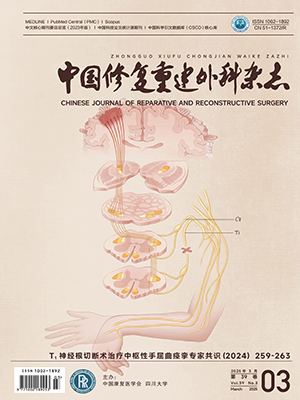Objective To assess the outcomes of pedicle subtration osteotomy and short-segment pedicle screw internal fixation in kyphosisdeformity. Methods From June 2001 to November 2003, 16 cases of kyphosis deformity were treated with pedicle subtration osteotomy and short-segment pedicle screw internal fixation, including 11 males and 5 females and aging 24-51 years. The kyphosis deformity was caused by ankylosing spondylitis in 12 cases, old lumbothoracic fracturedislocation in 2 cases, and vertebral dysplasia in 2 cases. The disease course was 7-25 years with an average of 12.8years. The whole spine radiographs were taken pre-and postoperatively. The sagittal balance was assessed by measuring thoracic kyphosis angle, lumbar lordosis angle, acrohorizontal angle and distance between posterosuperior point of S1and the vertical line. The clinical outcomes were assessed by Bridwell-Dewald scale for spinal disorders. Results The mean follow-up period was25.6 months. The mean bleeding was 1 100 ml. Satisfactory bone graft healing was achieved at final follow-up. Complications were paralytic intestinal obstruction in 1 case, dura laceration in 1 case, and temporary lower limb paralysis in 2 cases. Final follow-up radiograph showed an increase in lumbar lordosis angle from 9.6±16.4° to 42.6±14.3°(P<0.05), whereas thoracic kyphosis angle remained relative stable. The distance between posterosuperior point of S1 and the vertical line was decreased from 97.5±45.6 mm to 10.7±9.6 mm(P<0.05). Satisfactory clinical outcome was achieved by evaluating the changes of pain, social and working status. Conclusion Pedicle subtraction osteotomy and short-segment pedicle screw internal fixation is effective for correction of kyphosis deformity.
Citation: WANG Huimin,TAN Mingsheng,CHEN Wenzhi,et al.. TREATMENT OF KYPHOSIS DEFORMITY WITH PEDICLE SUBTRATION OSTEOTOMY ANDSHORT-SEGMENT PEDICLE SCREW INTERNAL FIXATION. Chinese Journal of Reparative and Reconstructive Surgery, 2006, 20(11): 1083-1086. doi: Copy
Copyright © the editorial department of Chinese Journal of Reparative and Reconstructive Surgery of West China Medical Publisher. All rights reserved




